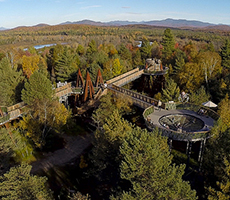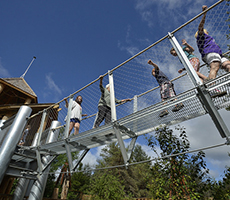Did you know that there’s more genetic diversity in a flock of chickadees than at a meeting of the United Nations? Or that raptors scan the ground for food along mouse highways marked by ultraviolet trails? Spend a few hours at The Wild Center in Tupper Lake, N.Y.—and its new Wild Walk—to learn these and other interesting facts about nature and the environment around you. 
Elements along the Wild Walk share many similarities with modern and traditional adventure parks. Guests enjoy the natural environment from an elevated viewpoint, but helmets and harnesses aren’t required. We chose to feature this attraction for its unique design and the possibilities it opens up for other operations interested in a new way to provide some thrill, education, and fun.
Learning About the Wild
The Wild Center opened in 2006 as a non-profit education institution and museum. Its purpose is to study and communicate the natural history of the six-million-acre Adirondack Park. The Center uses a unique hands-on approach to help audiences increase their understanding of how natural systems work in the Adirondacks and, by extension, the places visitors call home.
The institution sits on an 81-acre campus at the geographic center of New York’s Adirondacks. Location is key to its mission, as the Adirondacks provide a unique opportunity for education about nature and natural resources. Once heavily forested and damaged by human activity, the Park has been allowed to recover and restore itself, at times assisted by humans. The science community regards the Adirondacks as a vitally important experiment. Unusual geology beneath the Adirondacks adds to the allure.
Since its inception, the Center has worked to break new ground in how museums and science centers work. Providing a center for education about the natural world where people can come in “close and personal contact with the phenomena of nature” is a core goal.
The Wild Walk
The center’s Wild Walk took more than eight years to imagine and build before it opened in July 2015. It aligns with the Center’s core goal by providing an outdoor museum experience that compliments the educational component of The Wild Center.

“The Wild Walk is designed to be what would happen if you took a museum outdoors and put it in the center of what you were interpreting,” says Tracey Legat, communications manager at The Wild Center.
The award-winning Wild Walk is more than 1,000 feet long and follows a winding trail of bridges and platforms that begin at ground level and elevate to the treetops of the Adirondack forest, 40 feet off the ground. It’s accessible to all ages and abilities, including guests with mobility limitations.
The structure, says Legat, is designed to transform the way people see into the natural world by showcasing the perspective of the rest of nature—literally a birds-eye view.
A conical structure meant to mimic a conifer tree is the main architectural design element, and is one of six towers. Legat says each of the six towers offers a different educational opportunity. One talks about animal senses, and why they’re stronger than human senses, while another talks about migrating birds and why some stay in the Adirondacks in winter.
In fact, every element of the Wild Walk incorporates an education component. The design is meant to educate visitors by placing them in the natural environment they’re learning about. “You can go into the Wild Center and look at an exhibit about the history of the Adirondacks, then take the information to the Wild Walk and see it directly in front of you,” says Legat.
And, it’s fun. The interactive experience includes a four-story twig treehouse, swinging bridges, and a spider web made of rope and netting where people can hang out, suspended high above the forest floor. At the highest point is a full-size bald eagle’s nest that visitors stand in and imagine life as a great bird of prey. There’s also a snag—a concrete replica of a huge, broken white pine—that illustrates from the inside how much life a “dead” tree in the forest supports.
Naturalists are stationed along the walk, and four educational trunk programs feature info on outdoorsy topics like wild mushrooms or flying squirrels. 
Architect Charles P. “Chip” Reay was the lead designer of The Wild Center and the Wild Walk experience. His work on the Wild Walk started around the time the Center opened in 2006. With The Wild Center, Reay strove to create a new kind of museum that relied on living things rather than dead things to tell its story. “I wanted to connect everything to the landscape, not to objects in glass boxes,” Reay has said. Similarly, he designed the Wild Walk to be a sort of “outgrowth” of the forest.
Raey’s design for Wild Walk garnered the Excellence Award from the Society of American Registered Architects, Celebration of Architecture and Design Prize in 2016.
This new kind of museum experience has earned praise for the Wild Walk, which has been profiled in major media outlets including the New York Times and Wall Street Journal. (“An Ewokian fever dream come to life,” says Mother Nature News.)
The Wild Center ranks as the number-one attraction in the Adirondacks, and Legat says the Wild Walk drew 150,000 visitors last year.
ADA accessible, individual and group prices are available. In 2016, the Wild Walk will be open Memorial Day through October, and weekends only after Columbus Day. www.wildcenter.org.




